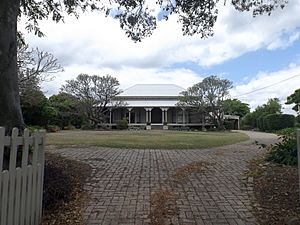Kyeewa facts for kids
Quick facts for kids Kyeewa |
|
|---|---|

Residence and front garden, 2015
|
|
| Location | 1 York Street, East Ipswich, City of Ipswich, Queensland, Australia |
| Design period | 1870s - 1890s (late 19th century) |
| Built | c. 1890 |
| Built for | Ernest Greenway |
| Official name: Kyeewa | |
| Type | state heritage (landscape, built) |
| Designated | 21 October 1992 |
| Reference no. | 600602 |
| Significant period | 1880s-1890s (fabric) 1880s- (historical) |
| Significant components | residential accommodation - main house, garden/grounds, trees/plantings |
| Lua error in Module:Location_map at line 420: attempt to index field 'wikibase' (a nil value). | |
Kyeewa is a beautiful old house in East Ipswich, Australia. It was built around 1890 for a man named Ernest Greenway. Today, Kyeewa is listed on the Queensland Heritage Register. This means it's an important historical place that needs to be protected.
Contents
The Story of Kyeewa
Kyeewa was built by workers from Ernest Greenway's own business. He owned a company that made things from stone. The stone used for the house likely came from the Helidon area.
Ernest Greenway came from a family of skilled workers. For many generations, his family were known as quarrymen, architects, builders, and stonemasons. They were experts at working with stone. Ernest Greenway was even related to a famous architect named Francis Howard Greenway.
Ernest Greenway married Elizabeth Femister. Her father, Alexander Femister, was well-known for his work with wallpaper and upholstery. Ernest and Elizabeth lived in Kyeewa.
The house was built around 1890. Records show that in 1889, the Greenways lived on Grey Street. But by 1891, they were living at Kyeewa. This suggests they moved into the house around that time.
Ernest Greenway's son, Gordon, was born in 1894. He lived at Kyeewa until at least 1986. Gordon followed in his family's footsteps. He became an architect, working with famous architects in Ipswich and Brisbane.
Originally, Kyeewa had a much larger piece of land. It even had an orchard (a garden with fruit trees) and stables for horses. The stables used to be where another house now stands.
The house wasn't finished exactly as planned. The back part of the house was built from timber, not sandstone like the front. When it was first built, the stone part of the house only had two bedrooms, a hallway, and a drawing room. The timber part held the kitchen.
Over the years, Kyeewa has had some new parts added. In 1990, a two-story extension was built at the back. Another two-story extension was added in 1999.
What Kyeewa Looks Like
Kyeewa is a large, impressive house made of sandstone. It has a long, ridged roof made of corrugated iron. The house sits on the highest spot on its street. It is also set far back from the road.
The house has a wide verandah (a covered porch) that wraps around three sides. The front verandah faces north. The main roof has decorative brackets under its eaves. The house is built on brick supports, sitting less than a meter off the ground.
The verandahs are simple and elegant, without railings. The wooden posts that hold up the verandah roof have carved tops. They also have triangular, cast-iron decorations. The front steps are now made of sandstone, but they were probably made of timber originally.
The walls facing the verandahs are made of rough-cut sandstone. They have smooth stone blocks, called quoins, at the corners and around the windows. Large, three-sided bay windows stick out onto the verandah on both sides of the main entrance.
The back of the house, which you can't see from the street, is made of timber. The garden around Kyeewa is also very special. It has many old trees, like a large Moreton Bay fig, a mango tree, and beautiful jacaranda and frangipani trees. These trees add a lot to the property's beauty and value.
Why Kyeewa is a Heritage Site
Kyeewa was added to the Queensland Heritage Register on October 21, 1992. It met several important rules to be listed:
Showing Queensland's History
Kyeewa helps us understand how Ipswich grew. In the late 1800s, Ipswich was a busy place for business and industry. This led to the building of grand homes like Kyeewa. These homes are still an important part of the city's history.
A Great Example of Its Kind
Kyeewa is a wonderful example of a large colonial home. Its size and location show how important it was. The house and its garden are still in great condition. This makes it a perfect example of this type of historic building.
Its Beautiful Look
Kyeewa has important aesthetic value. This means it is very pleasing to look at. It adds to the beauty of York Street, which has many houses that are architecturally interesting. Kyeewa's position on a large, sloping block of land, its mature gardens, and its decorative fence all make it very beautiful.
Connected to Important People
Kyeewa has a special connection to the Greenway family. It was their family home for many years. The Greenways were known for their work in architecture and stonemasonry. Ernest Greenway, who built the house, was a famous stonemason in Ipswich.



